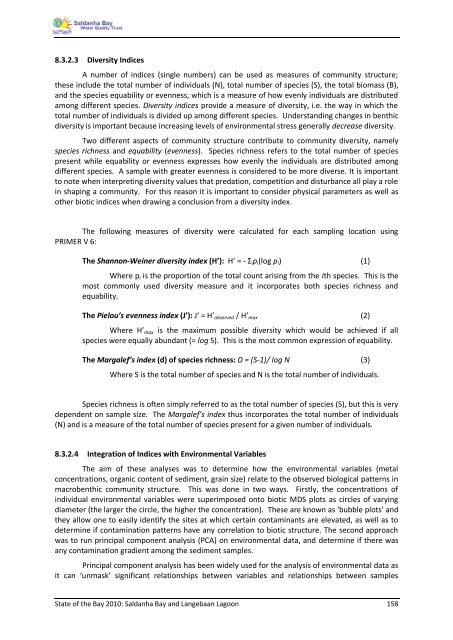State of the Bay Report 2010-Final - Anchor Environmental
State of the Bay Report 2010-Final - Anchor Environmental
State of the Bay Report 2010-Final - Anchor Environmental
Create successful ePaper yourself
Turn your PDF publications into a flip-book with our unique Google optimized e-Paper software.
8.3.2.3 Diversity Indices<br />
A number <strong>of</strong> indices (single numbers) can be used as measures <strong>of</strong> community structure;<br />
<strong>the</strong>se include <strong>the</strong> total number <strong>of</strong> individuals (N), total number <strong>of</strong> species (S), <strong>the</strong> total biomass (B),<br />
and <strong>the</strong> species equability or evenness, which is a measure <strong>of</strong> how evenly individuals are distributed<br />
among different species. Diversity indices provide a measure <strong>of</strong> diversity, i.e. <strong>the</strong> way in which <strong>the</strong><br />
total number <strong>of</strong> individuals is divided up among different species. Understanding changes in benthic<br />
diversity is important because increasing levels <strong>of</strong> environmental stress generally decrease diversity.<br />
Two different aspects <strong>of</strong> community structure contribute to community diversity, namely<br />
species richness and equability (evenness). Species richness refers to <strong>the</strong> total number <strong>of</strong> species<br />
present while equability or evenness expresses how evenly <strong>the</strong> individuals are distributed among<br />
different species. A sample with greater evenness is considered to be more diverse. It is important<br />
to note when interpreting diversity values that predation, competition and disturbance all play a role<br />
in shaping a community. For this reason it is important to consider physical parameters as well as<br />
o<strong>the</strong>r biotic indices when drawing a conclusion from a diversity index.<br />
The following measures <strong>of</strong> diversity were calculated for each sampling location using<br />
PRIMER V 6:<br />
The Shannon-Weiner diversity index (H’): H’ = - Σipi(log pi) (1)<br />
Where pi is <strong>the</strong> proportion <strong>of</strong> <strong>the</strong> total count arising from <strong>the</strong> ith species. This is <strong>the</strong><br />
most commonly used diversity measure and it incorporates both species richness and<br />
equability.<br />
The Pielou’s evenness index (J’): J’ = H’observed / H’max<br />
Where H’max is <strong>the</strong> maximum possible diversity which would be achieved if all<br />
species were equally abundant (= log S). This is <strong>the</strong> most common expression <strong>of</strong> equability.<br />
The Margalef’s index (d) <strong>of</strong> species richness: D = (S-1)/ log N (3)<br />
Where S is <strong>the</strong> total number <strong>of</strong> species and N is <strong>the</strong> total number <strong>of</strong> individuals.<br />
Species richness is <strong>of</strong>ten simply referred to as <strong>the</strong> total number <strong>of</strong> species (S), but this is very<br />
dependent on sample size. The Margalef’s index thus incorporates <strong>the</strong> total number <strong>of</strong> individuals<br />
(N) and is a measure <strong>of</strong> <strong>the</strong> total number <strong>of</strong> species present for a given number <strong>of</strong> individuals.<br />
8.3.2.4 Integration <strong>of</strong> Indices with <strong>Environmental</strong> Variables<br />
The aim <strong>of</strong> <strong>the</strong>se analyses was to determine how <strong>the</strong> environmental variables (metal<br />
concentrations, organic content <strong>of</strong> sediment, grain size) relate to <strong>the</strong> observed biological patterns in<br />
macrobenthic community structure. This was done in two ways. Firstly, <strong>the</strong> concentrations <strong>of</strong><br />
individual environmental variables were superimposed onto biotic MDS plots as circles <strong>of</strong> varying<br />
diameter (<strong>the</strong> larger <strong>the</strong> circle, <strong>the</strong> higher <strong>the</strong> concentration). These are known as ‘bubble plots’ and<br />
<strong>the</strong>y allow one to easily identify <strong>the</strong> sites at which certain contaminants are elevated, as well as to<br />
determine if contamination patterns have any correlation to biotic structure. The second approach<br />
was to run principal component analysis (PCA) on environmental data, and determine if <strong>the</strong>re was<br />
any contamination gradient among <strong>the</strong> sediment samples.<br />
Principal component analysis has been widely used for <strong>the</strong> analysis <strong>of</strong> environmental data as<br />
it can ‘unmask’ significant relationships between variables and relationships between samples<br />
<strong>State</strong> <strong>of</strong> <strong>the</strong> <strong>Bay</strong> <strong>2010</strong>: Saldanha <strong>Bay</strong> and Langebaan Lagoon 158<br />
(2)

















